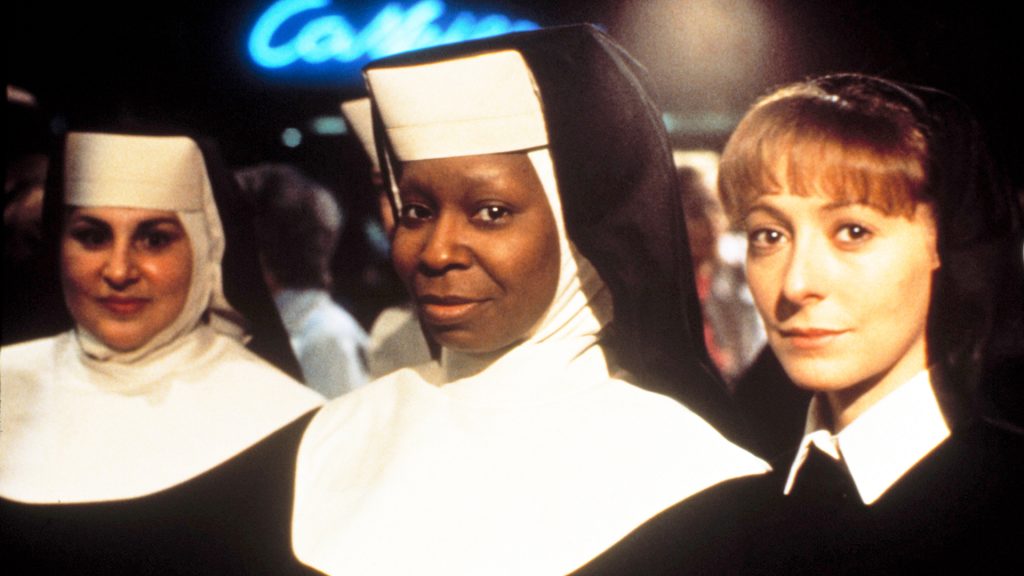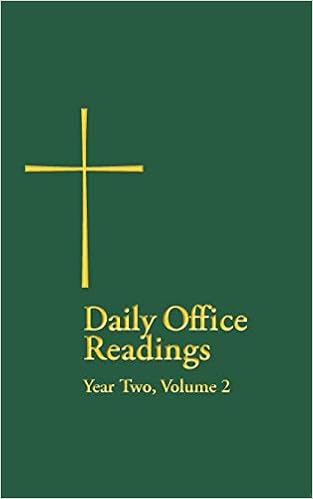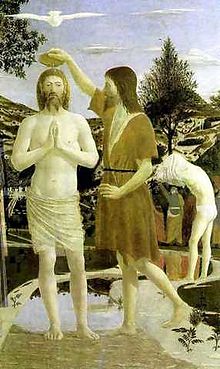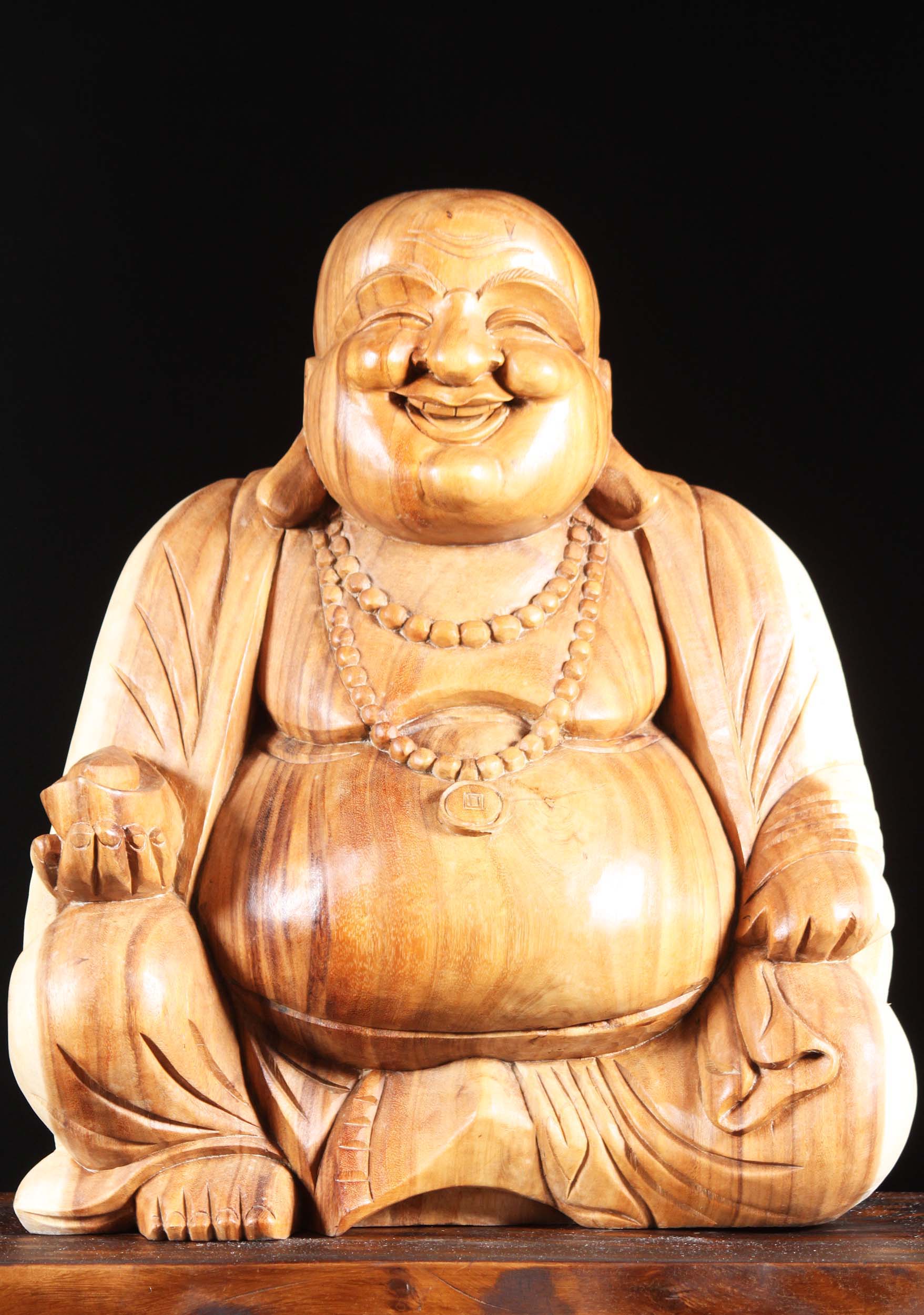
* * * *
This post is on catching up on “skipped Propers” that often happen at the beginning of a new Liturgical Season. And about “going back to my roots.” Back to the day when I first started reading the Bible on a daily basis. Way back on May 18, 1992 – 11 days before Sister Act.

That is, two weeks ago last May 31, 2020, I did the Daily Office reading for Pentecost Sunday. (According to the Daily Office Lectionary – and my copy of “Year 2, Volume 2,” at left – of the four-volume set.)
But then for the next day’s reading, I had to skip ahead some 42 pages, to the reading for the week after “the Sunday closest to June 1.” So from that next Monday-after-Pentecost on, I had to – or really, chose to – read not only the reading for that particular day. In addition, I also had to (chose to) also read some of the “skipped Propers.”
Which means that by Saturday, June 6, 2020, I’d done the scheduled Daily Office readings, plus some skipped Propers. (And according to the Daily Office Lectionary, those Saturday readings were Psalm 55, Psalm 138, and Psalm 139, along with Ecclesiastes 5:8-20, Galatians 3:23-4:11, and Matthew 15:1-20.) But also on that Saturday I had to do some more catching up.
That’s because – as noted – Pentecost came on May 31, but after that the daily readings jumped from page 12 to page 54. (Of Year 2, Volume 2.) To explain better, “Proper 1” starts the readings for the weeks of the Season after Pentecost. And it starts with the Sunday closest to May 11. Which means that this year Daily Office readers had to skip ahead to Proper 4, for the week of the Sunday closest to June 1st. But because I’m assiduous, I don’t like to skip those “in-between readings.” (Readings “in between” those listed for Proper 1, up to the start of Proper 4.)
So each morning – that first week of June, 2020 – and after doing the “proper” reading for that particular day, I tried to read one or two of the skipped readings. And so, by that Saturday – June 6, 2020 – I had gotten caught up as far as the reading for the Monday of Proper 2. (For the Week of the Sunday closest to May 18. Which of course had already passed.) And there – on page 25 of Year 2, Volume 2 – I saw my handwritten notation, “5/18/92.”
As it turns out, that date was – as far as I can tell – the day that I first started reading the Bible, on a daily basis, through the discipline of the Daily Office. And the readings for that day – now over 28 years ago – started off with Psalms 1, 2, 3, 4 and 7. (Another note: When I’m in the process of catching up at the beginning of a new liturgical season, I normally skip the day’s psalms.)
Which brings up some of the main readings for that day, over 28 years ago, starting with Proverbs 3:11-2. (That set of proverbs began with “My son, do not despise the LORD’s discipline.”) Those readings also included 1st John 3:18-4:6, starting with “Dear children, let us not love in word and speech but in deed and truth.” (Which seems especially appropriate these days.)

And also Matthew 11:1-6. (Which told of Jesus and John the Baptist – at left – with John in prison, asking if Jesus was “he who is to come?”) Which led in turn to this especially-relevant note, for today: The New Testament reading which included 1st John 4:1.
One version of that passage reads,”Dear friends, do not believe every spirit, but test the spirits to see whether they are from God.” (It continues, “because many false prophets have gone out into the world.”) Which – strange as it may seem – mirrors perfectly what I was trying to say in Pentecost 2020 – “Learn what is pleasing to the Lord.” For example, in that post I cited 1st Thessalonians 5:21.
In the Good News Translation, “Put all things to the test: keep what is good.” And in the Aramaic Bible in Plain English, “Explore everything and hold what is excellent.”
So the point of that last post was that by such open-minded “exploring,” we real Christians can achieve that rich life experience that Jesus promised. (John 10:10.) And that – to each individual – is the surest proof that God “is.” The surest proof that there is a God and that “He” is willing to work with us as individuals, to help us grow spiritually.
And as audacious as that claim sounds, it’s part of the Wesleyan Quadrilateral.

That – as noted in Pentecost … “pleasing to the Lord” – is a method of theological reflection. I.e., a spiritual discipline by which we attain personal spiritual growth. It’s credited to John Wesley (at left), who noted four sources of such growth: Scripture, tradition, reason, and Christian experience:
Apart from scripture, experience is the strongest proof of Christianity… Wesley insisted that we cannot have reasonable assurance of something unless we have experienced it personally… Although traditional proof is complex, experience is simple… Although tradition establishes the evidence a long way off, experience makes it present to all persons.
Which – as it turns out – is hardly a novel idea. (That is, it’s hardly unique to Christianity.) Consider for example what Gautama Buddha – seen “below” – once explained:
Do not believe on the strength of traditions even if they have been held in honor for many generations… Believe nothing which depends only on the authority of your masters or priests. After investigation, believe that which you yourself have tested and found reasonable, and which is good for your good and that of others.
Which – by the way – is a quote I cited in Jesus Christ, Public Defender. It’s now a Kindle Book but I originally published it in paperback form in 1995. (The Kindle edition was published under the nom de plume “James B. Ford.”) Then too – right after the Buddha quote, in Chapter 8, “The Bible, Yoga and Zen” – I went on to cite 1st Thessalonians 5:21 and 1st John 4:1.
That is, a mere two years after I started reading the Bible on a daily basis, I published my first novel, “Zen in the Art of College Football.” Then in 1995 – one year after “Zen Football” and a mere three years after I started Daily Office reading – I published Jesus Christ, Public Defender. (Now in its 4th Edition. And for more details on the life-long pilgrimage that followed, see – from February 2019 – the post On my “mission from God.”)

So, can you say to come full circle? But in the good way. Like the Buddhist anecdote: “A child looks at a mountain and sees a mountain. An adult looks at a mountain and sees many things. A Zen master looks at a mountain and sees a mountain.” But the point of all this is: My starting to read the Bible on a daily basis – back in 1992 – turned out to be a life-changing experience.
I’ve been through a lot since then. The death of my first wife in 2006, getting re-married way too soon and to the wrong woman. Which led to a nasty divorce, the loss of my career and my home – and to feeling abandoned by God. (As in, “Lead us not to the breaking point,” but He did, and I broke.) All of which just might be the functional equivalent of the exile that led to the creation of the Old Testament as we know it. See “If I Forget Thee, Oh Jerusalem,” in which talked about my then-upcoming trip to Israel in May 2019.
Which brings up the point that in the past few years I’ve come through and had a number of great adventures. Like that 2019 trip to Israel. And like canoeing 12 miles off the coast of Mississippi for eight days. (See On achieving closure, or type in that search.) Or hiking the Chilkoot Trail, then canoeing 440 miles “down” the Yukon River in Canada in 2016. Or hiking the Camino de Santiago twice, once from Pamplona (2017) and once from Porto, Portugal (2019).
And I’ve been publishing two blogs, and a number of books as well. (For a partial list see For a book version.) In other words, I’ve overcome any number of obstacles and arrived at a rich, fulfilling life. And it all started back on Monday, May 18, 1992…
* * * *

An open-minded Christian can learn even from a “Fat Buddhist…”
* * * *
The upper image is courtesy of May 1992 – Image Results. See also Sister Act – Wikipedia, and Sister Act (1992) – IMDb.
The “liturgical seasons” link is to The Liturgical Seasons of the Catholic Church. But see also Liturgical year – Wikipedia, about the “cycle of liturgical seasons in Christian churches that determines when feast days, including celebrations of saints, are to be observed, and which portions of Scripture are to be read either in an annual cycle or in a cycle of several years.” And List of Anglican Church Calendars, on “my” church’s seasons. “Ordinary time” or the “Time after Pentecost” runs from Pentecost Sunday to the beginning of Advent, which leads to Christmas, and so on…
Re: Handwritten notations. When I do a “daily” reading on the noted day, or within three days thereafter, I put in the relevant date, such as “5/18/92.” That signifies that I have read both the main readings – normally Old Testament, New Testament and Gospel – and the Psalms for that day. But when I can’t do a reading “within three days” – like when I have to “skip some Propers” – I put a check mark. That means I’ve done the main readings but not the Psalms. And according to those dates and check marks, I’m now on my 14th trip through the Bible.
The John the Baptist image is courtesy of Wikipedia. The caption: “‘The Baptism of Jesus Christ,‘ by Piero della Francesca, 1449.”
Re: Monday, May 18, 1992. See Calendar 1992 May – Image Results.
The Buddha quote is courtesy of Lawrence LeShan‘s book How to Meditate: A Guide to Self-Discovery, Bantam Edition, 1975, at pages 101-102. See also On the Bible as “transcendent” meditation. Also, as noted, On my “mission from God.”
The citations to 1st Thessalonians 5:21 and 1st John 4:1 – following the Buddha quote – are at page 53 of the Third Edition paperback version of “JCPD,” in Chapter 8, “The Bible, Yoga and Zen.”
Re: “Come full circle.” See also Alpha and Omega (Freedictionary), or the Wikipedia article.
Re: “Lead us not to the breaking point.” That’s an interpretation from one of Garry Wills‘ books, and it seemed especially appropriate for my life. As in, “I was led to the breaking point, and broke.” See also Luke 11:4 (Bible Hub), which includes the usual translations of the Lord’s Prayer, “And lead us not into temptation, but deliver us from evil.” The Good News Translation reads, “And do not bring us to hard testing.” But for the reasons noted, I prefer “And lead us not to the breaking point…”
The lower image is courtesy of Fat Happy Buddha – Image Results. But see also Skinny Buddha vs Fat Buddha: Who is the Fat Buddha, noting the Fat Buddha wasn’t “Buddha” at all:
The Laughing Buddha, or the Fat Buddha, was a Zen monk called Budai who lived in China around the 10th century, meaning about 1.600 years after historical Buddha. Budai was as a bold man with a big tummy, big smile, large ears, wearing a simple robe… The fat Buddhist monk was known as a good-hearted, happy and content man of humorous personality, jolly nature, and eccentric lifestyle. Budai was nicknamed the Laughing Buddha because of his big smile and happiness he was spreading around him. Furthermore, Budai … became a famous character of Chinese folktales.
Thus the “Gautama Buddha – ‘below,’” with the “below” in quotation marks.